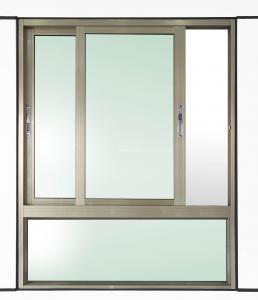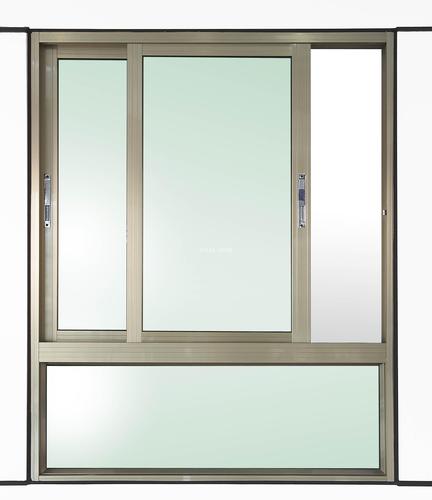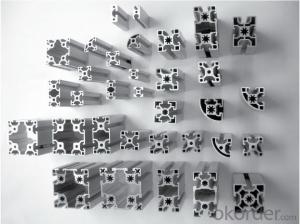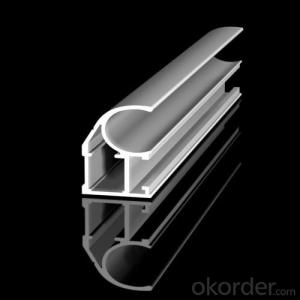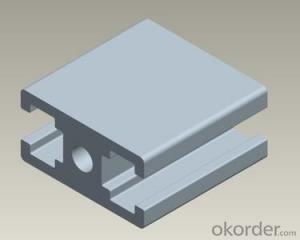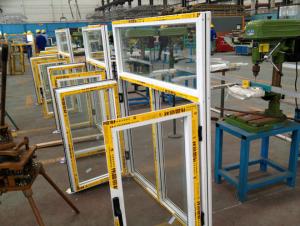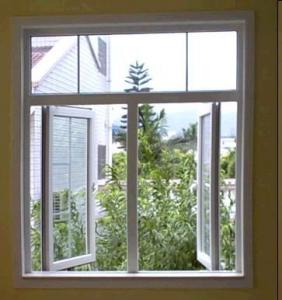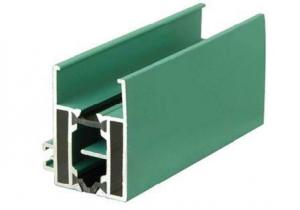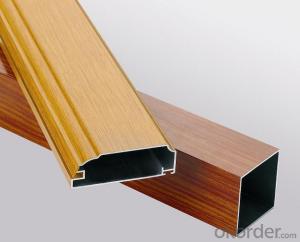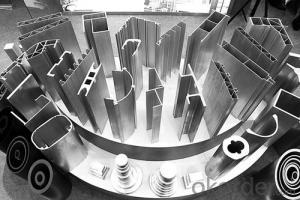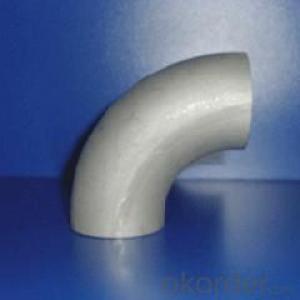Aluminum Extrusion Profiles for Windows AA6063
- Loading Port:
- China Main Port
- Payment Terms:
- TT OR LC
- Min Order Qty:
- -
- Supply Capability:
- -
OKorder Service Pledge
OKorder Financial Service
You Might Also Like
Powder Coating Aluminum door profile of - AA6060
1) Material : 6063 6061 6060 and different aluminium alloy
2) Alloy Temper: T4 T5 T6 or other special status as per customer's needing.
3) Optional Surface treatment: mill finish, anodized sliver ,anodized bronze, anodized champagne, anodized black pearl, various power coating color, electrophoretic sliver, electrophoretic champagne, electrophoretic golden,
electrophoretic titanium, machine polish sliver, machine polish bronze, wooden grain color, and Fluorocarbon spraying.
4) Annual capacity : 120000TON
5) Quality : China Nation Standard GB/T 5237 2004 (advanced class)
6) Application: can be widely used for aluminium window, door, curtain wall, hand railing ,
normal aluminium profiles, decoration and industrial aluminium profiles.
7) Advantage: Famous Brand reasonable&market price, soonest delivery and good after sale- service
- Q: How do aluminum profiles perform in load-bearing structures?
- Aluminum profiles are known for their excellent performance in load-bearing structures. Due to their high strength-to-weight ratio, aluminum profiles offer significant advantages over other materials in terms of structural integrity and overall weight reduction. The inherent strength of aluminum profiles enables them to support heavy loads, making them suitable for various load-bearing applications. Whether it is in buildings, bridges, or industrial structures, aluminum profiles can effectively withstand and distribute heavy loads, ensuring reliable and safe performance. Additionally, aluminum profiles have exceptional corrosion resistance, which is crucial for load-bearing structures exposed to harsh environments or outdoor conditions. This corrosion resistance ensures the longevity and durability of the structure, reducing maintenance and replacement costs in the long run. Furthermore, aluminum profiles are highly versatile and can be easily customized to meet specific design requirements. They can be extruded into various shapes and sizes, allowing for efficient integration into complex load-bearing structures. This versatility also enables the use of aluminum profiles in unique architectural designs, enhancing the aesthetics of the structure. Another advantage of aluminum profiles in load-bearing structures is their lightweight nature. Compared to traditional materials like steel, aluminum profiles are significantly lighter, resulting in easier and more cost-effective transportation, installation, and overall construction process. This makes aluminum profiles an ideal choice for projects where weight reduction is a priority. In conclusion, aluminum profiles excel in load-bearing structures due to their high strength-to-weight ratio, corrosion resistance, versatility, and lightweight properties. These characteristics make aluminum profiles a reliable and efficient choice for various load-bearing applications, providing durability, longevity, and cost-effectiveness to the overall structure.
- Q: What are the aluminum packaging methods?
- Common1 each cotton covered cotton;2 each sleeve;3 coat big bag plastic sealing;4, two wire line;5, three, wrapping paper;6, outsourcing cotton (outsourcing paper).....
- Q: Can aluminum profiles be used in the production of industrial robots?
- Indeed, industrial robots can be manufactured utilizing aluminum profiles. Aluminum, being a lightweight and long-lasting material, presents numerous benefits when constructing robotic systems. Its strength-to-weight ratio is impressively high, rendering it ideal for constructing solid and dependable robot structures. Machining aluminum profiles is a straightforward task, enabling the creation of intricate and precise designs for diverse robot components, including frames, arms, and joints. Furthermore, aluminum's resistance to corrosion proves advantageous in industrial environments where robots may encounter harsh chemicals or challenging surroundings. In summary, aluminum profiles offer a versatile and cost-effective solution for the production of industrial robots.
- Q: How do aluminum profiles perform in terms of static electricity discharge?
- Aluminum profiles are excellent conductors of electricity, which means they are highly effective in dissipating static electricity. Due to their low resistance, they can quickly and efficiently discharge static charges to the ground, reducing the risk of electrostatic discharge (ESD) and preventing damage to sensitive electronic components.
- Q: How do you prevent galvanic corrosion with aluminum profiles?
- To prevent galvanic corrosion with aluminum profiles, there are several steps that can be taken: 1. Use compatible materials: It is important to select materials that are compatible with aluminum to avoid galvanic corrosion. Avoid coupling aluminum profiles with dissimilar metals, such as copper, brass, or steel, as these combinations can accelerate the corrosion process. 2. Apply protective coatings: Applying a protective coating, such as anodizing or painting, can provide a barrier between the aluminum profiles and the surrounding environment. Anodizing creates a durable oxide layer on the surface of aluminum, which enhances its corrosion resistance. Painting with suitable corrosion-resistant paints can also provide an effective barrier against galvanic corrosion. 3. Insulate dissimilar metals: If it is necessary to use dissimilar metals in conjunction with aluminum profiles, it is crucial to insulate them from direct contact. This can be achieved by using gaskets, insulating materials, or non-conductive fasteners to separate the metals and prevent the electrical contact that causes galvanic corrosion. 4. Regular maintenance and cleaning: Regular cleaning and maintenance of aluminum profiles can help prevent galvanic corrosion. Removing any accumulated dirt, debris, or other contaminants from the surface can minimize the chances of corrosion initiation. 5. Control the environment: Controlling the environment in which aluminum profiles are used can also play a significant role in preventing galvanic corrosion. Avoid exposing aluminum to environments with high humidity, saltwater, or acidic conditions, as these can accelerate corrosion. Additionally, maintaining proper ventilation and moisture control can help minimize the risk of corrosion. By following these preventive measures, it is possible to significantly reduce the risk of galvanic corrosion and ensure the longevity and performance of aluminum profiles.
- Q: What are the different types of brackets used with aluminum profiles?
- There are several different types of brackets that are commonly used with aluminum profiles. These brackets serve various purposes and help in joining and securing the profiles to create sturdy structures. Some of the most common types of brackets used with aluminum profiles include: 1. Corner brackets: These brackets are used to connect two aluminum profiles at a right angle. They are typically L-shaped and provide a strong and stable connection. 2. T-slot nuts: These nuts are specially designed to fit into the T-slots of aluminum profiles. They allow for the attachment of various accessories and components to the profile, such as panels, hinges, or locks. 3. Angle brackets: Angle brackets are used to create connections between aluminum profiles at different angles other than 90 degrees. They are typically adjustable to accommodate various angles. 4. Joining plates: Joining plates are used to connect two or more aluminum profiles end-to-end, creating longer sections. These plates provide a secure connection and maintain the structural integrity of the profiles. 5. Gusset brackets: Gusset brackets are triangular brackets that are used to reinforce the connections between aluminum profiles. They provide additional strength and stability to the structure, particularly at joints. 6. Panel brackets: Panel brackets are used to attach panels or sheets to aluminum profiles. These brackets typically have a slot or groove that allows for the easy insertion and secure attachment of panels. 7. Mounting brackets: Mounting brackets are used to attach the aluminum profiles to walls, floors, or other surfaces. They provide a secure mounting point for the profiles, allowing for the creation of stable structures. These are just a few examples of the different types of brackets used with aluminum profiles. The specific type of bracket required will depend on the application and the desired structure being created with the aluminum profiles.
- Q: The latest list of aluminum China
- The first aluminum aluminum (China Aluminum Group, the central management of large state-owned enterprises)Second of Asia Aluminum (Asia Aluminum Group, Asia's largest aluminum producer, Chinese brand)Third strong aluminum products (China famous brand, national inspection free products)Fourth (Chinese Fenglv aluminum material brand, national Mianjian products)Fifth Zhong Zhong aluminum (China famous brand, China well-known trademark, national inspection free products)Sixth (Chinese Hing Fat aluminum brand, A Well-Known Trademark in China, national Mianjian products)Seventh South Asia Aluminum profiles (China famous brand, national inspection free products)Eighth Nanshan aluminum (China famous brand, China well-known trademark, national inspection free products)Ninth by court aluminum profiles (China well-known trademarks, national inspection free products)Albert tenth aluminum (China famous brand, national inspection free products)
- Q: What are the anti-static properties of aluminum profiles?
- The anti-static properties of aluminum profiles refer to their ability to prevent or dissipate static electricity buildup. Aluminum is a conductive material, allowing it to quickly discharge any static electricity that may accumulate on its surface. This property helps to prevent the buildup of electrostatic charges, which can be harmful to electronic components or cause problems in sensitive environments such as cleanrooms or manufacturing facilities.
- Q: Can aluminum profiles be used in the construction of modular office spaces?
- Certainly, modular office spaces can undoubtedly utilize aluminum profiles in their construction. With their lightweight nature, durability, and exceptional structural integrity, aluminum profiles prove to be an excellent option for modular construction projects. They can be effortlessly fabricated and assembled to form a variety of components, including walls, partitions, doors, windows, and framing systems for modular office spaces. Furthermore, aluminum profiles offer immense design flexibility, enabling customization and adaptation to diverse office layouts and requirements. Moreover, they possess high resistance to corrosion, which proves particularly advantageous in office environments susceptible to moisture and humidity. In essence, aluminum profiles offer a multitude of benefits in terms of strength, versatility, and aesthetics, rendering them a favored choice for construction in modular office spaces.
- Q: Is it possible to utilize recycled aluminum extrusions in a construction project to lessen the environmental footprint?
- <p>Yes, using recycled aluminum extrusions in your building project can significantly reduce environmental impact. Recycled aluminum requires less energy to produce compared to new aluminum, reducing greenhouse gas emissions. It also conserves natural resources by decreasing the need for mining. Additionally, incorporating recycled materials can contribute to a project's sustainability goals and potentially qualify for green building certifications, enhancing the building's marketability and appeal.</p>
Send your message to us
Aluminum Extrusion Profiles for Windows AA6063
- Loading Port:
- China Main Port
- Payment Terms:
- TT OR LC
- Min Order Qty:
- -
- Supply Capability:
- -
OKorder Service Pledge
OKorder Financial Service
Similar products
Hot products
Hot Searches
Related keywords
